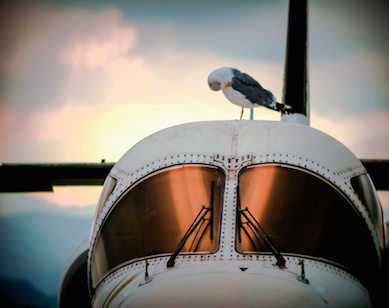With spring in full swing, most people notice the flowers blooming, the air getting warmer, and the daylight hours becoming longer. But for those of us who travel by air, you might also be noticing the large flocks of birds migrating back north this time of year.
Although bird strikes can happen any time of the year, airline officials may be on heightened alert during the colder months when larger flocks of birds take to the skies. Many people remember the story of “Sully” Sullenberger and US Airways flight 1549 that struck a large flock of Canadian geese during takeoff out of LaGuardia Airport on January 15, 2009. In this extremely rare incident, the Airbus A320 suffered bird strikes to both engines, resulting in total power loss to both sides. Stories like this can be unsettling for passengers who are about to take to the skies, but it’s important to take note of the rarity of these incidents and look at the facts before avoiding booking your next flight.

According to the Federal Aviation Administration, over 10,000 bird strikes occur each year, averaging more than 26 hits a day. So why are bird strikes becoming more common? Is it a result of better incident reporting by airline pilots, or does the environment we live in have something to do with the increased rates of occurrence? In an annual report released by the FAA/USDA in 2013, three factors have been linked to these rapid increases.
- There has been a dramatic increase to the population of large bird species that have adapted to living in urban areas, including airports. For example, “the resident (non- migratory) Canada goose population in the USA and Canada increased from about 0.5 million to 3.8 million from 1980 to 2013 (Dolbeer et al. 2014, U.S. Fish and Wildlife Service. 2013).”
- Commercial air traffic in the USA is increasing rapidly and is predicted to grow at a rate of about 1.5% each year. This means more passengers traveling by air and a demand for even more planes in the sky.
- Commercial air carriers are now replacing older three or four-engine aircrafts with more fuel efficient two-engine aircrafts. Two-engine aircrafts are more reliable, however they are also quieter, making them less detectable for birds. Also, two-engines may pose a risk during a multiple bird strike incident. “In the event of a multiple ingestion (e.g., the US Airways Flight 1549), aircraft with two engines may have vulnerabilities not shared by their three or four engine-equipped counterparts.”
Have no fear!
It’s clear that the facts show bird strikes as being a significant threat to the aviation world, however it’s imperative to note what type of threats birds pose. Usually bird strikes only cause minimal damages to the plane, resulting in more of an inconvenience to maintenance crews and airline schedules, rather then to the passengers themselves. Very few fatalities have occurred to human life as a result of a bird strike. In most instances, passengers are completely unaware that their plane has come in contact with a bird, and the flight usually continues on its way. If damage does occur however, pilots are trained to find the nearest airport to safely land the plane and proceed with maintenance inspections before carrying on with the original flight plan.
Let’s put your odds into perspective!

In today’s world, air travel is considered to be one of the safest modes of transportation. Most people don’t think twice about driving in a car, even though the odds of being in a fatal car crash are staggering around 1 in 112. When it comes to air travel safety and bird strikes, aviation experts are continuously looking for ways to improve overall safety. Airports take this issue very seriously and have put numerous techniques into place to prevent these strikes from even happening.
- Airports modify the habitat surrounding runways to make it less attractive to wildlife. This includes removing trees, eliminating food sources such as bugs and seeds, and covering ponds with netting to prevent landing.
- Noise generators and recorded predator calls are used to deter birds from lingering near airports.
- Some airports use trained falcons or dogs to scare away birds. When these methods fail, some airports go as far as capturing and releasing those “stubborn” birds that refuse to leave.
- Airports use radar systems to track nearby birds. If birds are suspected in the area, ATC may direct air traffic to different runways.
- Although difficult for major airports, some airports adjust flight times to avoid the busiest hours for bird activity.
- Pilots and flight crews are trained to use facts, data, and standard operating procedures to reduce the possibility and effects of a bird strike should one occur.
The reality is, bird strikes are going to happen, but the odds of this occurrence being life threatening to passengers is exceedingly low. Although easier said then done, nervous passengers need not to worry and should try to relax. If need be, reduce your stress by flying at night when the odds of a bird strike are drastically lower, or perhaps take a closer look at the numbers. Your odds are definitely in your favor, and airports take your safety very seriously by creating an environment that is ideal for planes to land. So the next time you look up to see a flock of geese soaring by, don’t cringe at the thought of flying in the skies next to them, enjoy their beauty and know that airports are doing their very best to keep you (and the birds) safe!
Do you have a bird strike story to share? We would love to hear from you! Email us at info@airportlifestyle.com or share your comments below!

